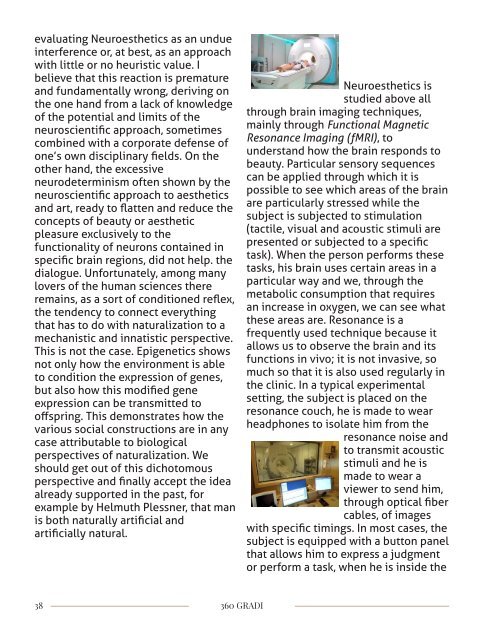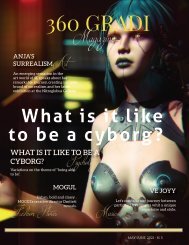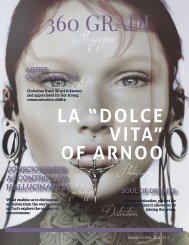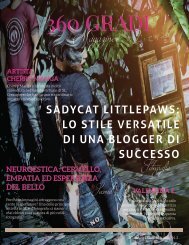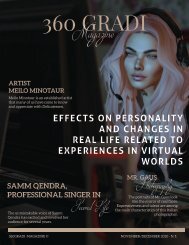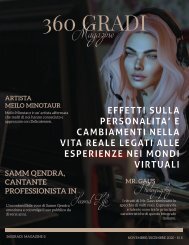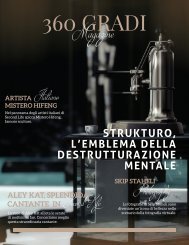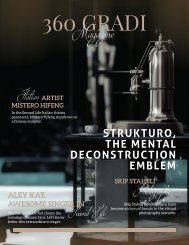360 GRADI MAGAZINE January/February 2021
The January/February 2021 issue of 360GRADI Magazine is online! All updates on our Fan Page: https://www.facebook.com/360gradisecondlifesionisti Don't forget to take our kiosk to put in your land! You won't miss an issue and you'll give a useful service to your visitors for free. Take your kiosk: http://maps.secondlife.com/secondlife/Petopia/217/216/4087 360 GRADI Magazine is the trendy, elegant, refined, and sophisticated publishing about Second Life (the virtual world by Linden Lab). Out every two months.
The January/February 2021 issue of 360GRADI Magazine is online!
All updates on our Fan Page: https://www.facebook.com/360gradisecondlifesionisti
Don't forget to take our kiosk to put in your land! You won't miss an issue and you'll give a useful service to your visitors for free.
Take your kiosk: http://maps.secondlife.com/secondlife/Petopia/217/216/4087
360 GRADI Magazine is the trendy, elegant, refined, and sophisticated publishing about Second Life (the virtual world by Linden Lab).
Out every two months.
You also want an ePaper? Increase the reach of your titles
YUMPU automatically turns print PDFs into web optimized ePapers that Google loves.
evaluating Neuroesthetics as an undue<br />
interference or, at best, as an approach<br />
with little or no heuristic value. I<br />
believe that this reaction is premature<br />
and fundamentally wrong, deriving on<br />
the one hand from a lack of knowledge<br />
of the potential and limits of the<br />
neuroscientific approach, sometimes<br />
combined with a corporate defense of<br />
one’s own disciplinary fields. On the<br />
other hand, the excessive<br />
neurodeterminism often shown by the<br />
neuroscientific approach to aesthetics<br />
and art, ready to flatten and reduce the<br />
concepts of beauty or aesthetic<br />
pleasure exclusively to the<br />
functionality of neurons contained in<br />
specific brain regions, did not help. the<br />
dialogue. Unfortunately, among many<br />
lovers of the human sciences there<br />
remains, as a sort of conditioned reflex,<br />
the tendency to connect everything<br />
that has to do with naturalization to a<br />
mechanistic and innatistic perspective.<br />
This is not the case. Epigenetics shows<br />
not only how the environment is able<br />
to condition the expression of genes,<br />
but also how this modified gene<br />
expression can be transmitted to<br />
offspring. This demonstrates how the<br />
various social constructions are in any<br />
case attributable to biological<br />
perspectives of naturalization. We<br />
should get out of this dichotomous<br />
perspective and finally accept the idea<br />
already supported in the past, for<br />
example by Helmuth Plessner, that man<br />
is both naturally artificial and<br />
artificially natural.<br />
Neuroesthetics is<br />
studied above all<br />
through brain imaging techniques,<br />
mainly through Functional Magnetic<br />
Resonance Imaging (fMRI), to<br />
understand how the brain responds to<br />
beauty. Particular sensory sequences<br />
can be applied through which it is<br />
possible to see which areas of the brain<br />
are particularly stressed while the<br />
subject is subjected to stimulation<br />
(tactile, visual and acoustic stimuli are<br />
presented or subjected to a specific<br />
task). When the person performs these<br />
tasks, his brain uses certain areas in a<br />
particular way and we, through the<br />
metabolic consumption that requires<br />
an increase in oxygen, we can see what<br />
these areas are. Resonance is a<br />
frequently used technique because it<br />
allows us to observe the brain and its<br />
functions in vivo; it is not invasive, so<br />
much so that it is also used regularly in<br />
the clinic. In a typical experimental<br />
setting, the subject is placed on the<br />
resonance couch, he is made to wear<br />
headphones to isolate him from the<br />
resonance noise and<br />
to transmit acoustic<br />
stimuli and he is<br />
made to wear a<br />
viewer to send him,<br />
through optical fiber<br />
cables, of images<br />
with specific timings. In most cases, the<br />
subject is equipped with a button panel<br />
that allows him to express a judgment<br />
or perform a task, when he is inside the<br />
38 <strong>360</strong> <strong>GRADI</strong>


